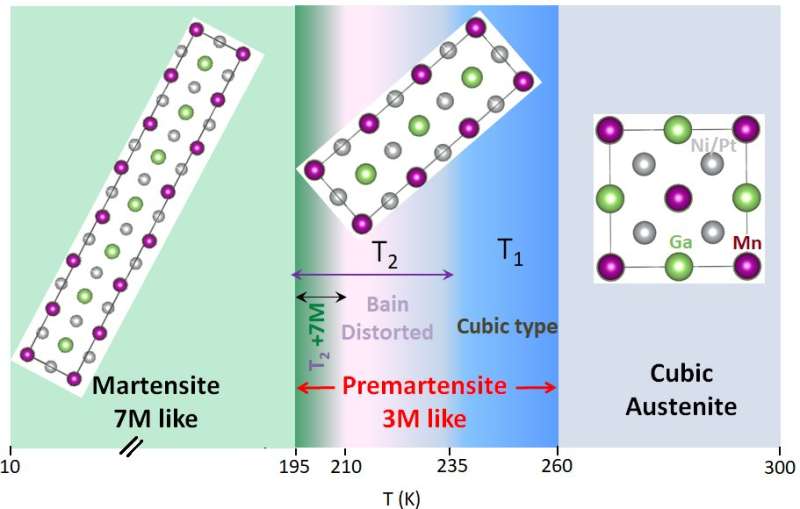Robust Bain distortion in the premartensite phase of a platinum-substituted Ni2MnGa

The premartensite phase of shape memory and magnetic shape memory alloys is believed to be a precursor state of the martensite phase with preserved austenite phase symmetry. The thermodynamic stability of the premartensite phase and its relation to the martensitic phase is still an unresolved issue, even though it is critical to the understanding the functional properties of magnetic shape memory alloys.
In a recent study, scientists from the Max Planck Institute for Chemical Physics of Solids in Dresden demonstrated unambiguous evidence for macroscopic symmetry breaking, leading to robust Bain distortion in the premartensite phase of 10 percent Pt-substituted Ni2MnGa using high resolution synchrotron x-ray diffraction study. They show that the robust Bain-distorted premartensite phase results from another premartensite phase with preserved cubic-like symmetry through an isostructural phase transition. The Bain-distorted premartensite phase finally transforms to the martensite phase with additional Bain distortion on further cooling. These results demonstrate that the premartensite phase should not be considered as a precursor state with the preserved symmetry of the cubic austenite phase. The gradual evolution of the Bain distortion can facilitate the emergence of an invariant habit plane. Therefore, such alloys may exhibit better reversibility due to lower hysteresis, which will enhance their applicability as magnetic actuators and in refrigeration technology.
The research at the Max Planck Institute for Chemical Physics of Solids (MPI CPfS) in Dresden aims to discover and understand new materials with unusual properties.
In close cooperation, chemists and physicists (including chemists working on synthesis, experimentalists and theoreticians) use the most modern tools and methods to examine how the chemical composition and arrangement of atoms, as well as external forces, affect the magnetic, electronic and chemical properties of the compounds.
New quantum materials, physical phenomena and materials for energy conversion are the result of this interdisciplinary collaboration.
More information: Sanjay Singh et al, Robust Bain distortion in the premartensite phase of a platinum-substituted Ni2MnGa magnetic shape memory alloy, Nature Communications (2017). DOI: 10.1038/s41467-017-00883-z
Journal information: Nature Communications
Provided by Max Planck Society




















